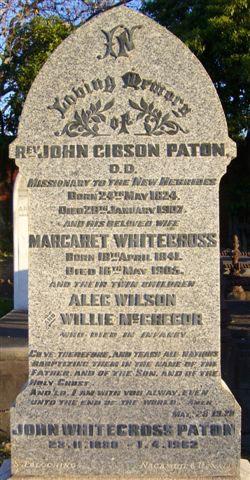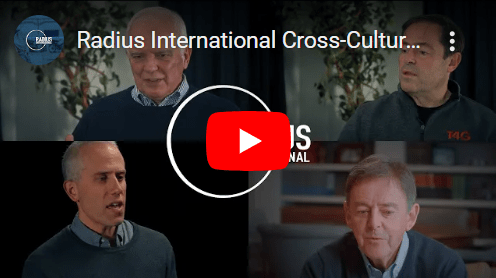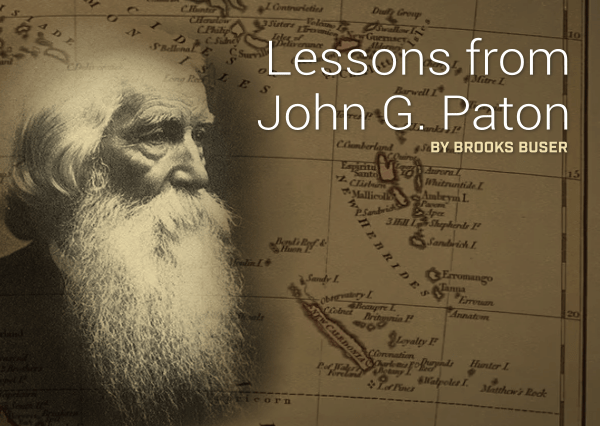Paton was born in Dumfrieshire Scotland on May 24th, 1824, the eldest of eleven children. It should be noted that Scotland was unusually blessed in the late 18th and 19th centuries to have so many notable men and women of character representing her in faraway lands. Robert Moffat born 1795, Alexander Duff (1806), David Livingston (1813), William Chalmers Burns (1815), and Mary Slessor (1848). Paton on one of his trips home would share of the need in the South Seas to such effect that 1 in 6 pastors in his Reformed Presbyterian Church of Scotland would rise to the challenge and depart for missions work overseas. It’s remarkable to contemplate what the sons of daughters of Scotland were hearing in their pulpits during this period of time that made them so ready to lay down their lives in service overseas.
Paton departed from his parents’ house in 1841, at seventeen years of age, and spent ten years at Glasgow in Medical and Theological studies. He would see unusual success in his ministry at the Green Street Mission but would remain immovable in his conviction that God was calling him to ministry in the South Seas. On March 23, 1858, he was ordained to ministry, eight days later he married Mary Ann Robson, and fourteen days later he set sail for the New Hebrides islands.
Three months after arriving on the island of Tanna his son was born, nineteen days later his wife Mary Ann died, and seventeen days later his son Peter Robert Robson also died. He would endure two and a half years of limited progress on Tanna and end up being forced off the island under threat of death. In June of 1864, he makes it back to Scotland to raise money for the work in the New Hebrides and meets and marries Margret Whitecross. He comes back to the New Hebrides in August 1866 but settles in Aniwa, rather than Tanna. He and Margret would have 10 children, but only 4 would live past childhood.
John and Margret learned the language, developed an orthography (alphabet), taught the Aniwans how to read and write, translated the Scriptures, established churches, and sent teachers to all the villages that spoke the Aniwan dialect and beyond. Eventually, the entire Island of Aniwa would profess Christianity.
 Paton would go on to mobilize thousands for the cause of missions, specifically to the unreached, many to the South Seas. In 1899, the Scripture translation was completed and brought into Aniwa in bound form and twenty-five of the thirty islands that make up the New Hebrides had missionary teams on them. Many of those teams were a result of Paton’s advocation and mobilizing for missions in the South Seas.
Paton would go on to mobilize thousands for the cause of missions, specifically to the unreached, many to the South Seas. In 1899, the Scripture translation was completed and brought into Aniwa in bound form and twenty-five of the thirty islands that make up the New Hebrides had missionary teams on them. Many of those teams were a result of Paton’s advocation and mobilizing for missions in the South Seas.
Margret Paton died in Victoria Australia in May 1905. She and John had been married for 41 years. John Paton died two years later in January 1907. They are both buried at Boorunda Cemetery in Victoria Australia.
It’s impossible to drill too deeply into a life so fully lived in such a short article, but let me propose three takeaways or lessons from what we know of the man.
- His Upbringing Fueled the Rest of His Life
Paton was raised in a home that took church and family worship seriously. His parents were devout church members and practiced family worship and family prayers twice daily. Paton embraced the value of the gathering of the saints on the Lord’s Day. He would say of him and his ten siblings, “There were eleven of us brought up in a home like that; and never one of the eleven, boy or a girl, man or woman, has been heard, or ever will be heard, saying that Sabbath was dull or worrisome for us.”[3]
Paton’s relationship with his father was remarkably close. There is scant information about the specifics in how he was raised but we know that he was no stranger to hard work, Bible memorization, and having the cause of the missions put front and center. He frequently speaks of the “God of his Father” and in a touching point gives credit to the memory of the first time he left his father for keeping him from sin in his early years, “…the memory of that scene not only helped to keep me pure from the prevailing sins, but also stimulated me in all my studies, that I might not fall short of his hopes, and in all my Christian duties, that I might faithfully follow his shining example.”[4]
But if we are to measure the full influence of Paton’s upbringing, it has to extend past John Paton himself and on to his children and grandchildren. The flame that was lit in Paton himself for world missions would pass to three of his four children, two of his grandsons, and one of his great-grandsons spanning over one hundred years of missionary service, nearly all of it in the South Seas.
Paton was never shy about his desire to see his children go into missions. He saw it as the “noblest service in which any human being could spend or be spent.”[5] Remember that Paton lost 6 of his 10 children, and at least four of those who died stood a much better chance of living if he had not been a missionary. And yet, Paton weighed this cost, presumably not just for him but for all of his future family members as well, and encouraged them on the path he himself had taken! “I deeply rejoice — when I breathe that prayer that it may please the blessed Lord to turn the hearts of all my children to the mission field; and that he may open up their way and make it their pride and joy to live and die in carrying Jesus and his gospel into the heart of the heathen world.”[6]
Paton’s upbringing steeled him for the challenges ahead, gave him love for God and hatred of sin, and helped him see with absolute clarity the way to live…and die.
- He Saw Missions through the Prism of Gospel Opportunity
What many people don’t understand is that Paton’s ministry at his church and the Green Street Mission was incredibly successful before he left for the South Seas. This was one of the major pushbacks to his leaving. How could someone seeing such fruit in ministry leave it behind for a likely quick and gruesome death?
But Paton saw the disparity in gospel opportunity as the dominating issue in where his gifts should be used and trusted God with the results. He would say, “Happy in my work as I felt, and successful by the blessing of God, yet I continually heard, and chiefly during my last ten years in the Divinity Hall, the wail of a perishing Heathen in the South Seas; and I saw that few were caring for them, while I well knew that many would be ready to take up my work in Carlton, and carry it forward perhaps with more efficiency than myself.”[7] Gospel opportunity was paramount to Paton. If someone had access to the Bible, and even more so if they had a church in their area, they had “all the means of grace within easy reach.” He felt duty bound to get to those who had no such access to the message of life.
This type of clarity and singlemindedness would later lead some to derisively label him a “one idea man.” Paton’s retort is sharper than our modern ears are used to. “When pleading the cause of the Heathen and the claims of Jesus on His followers, I have often been taunted with being “a man of one idea.” Sometimes I have thought that this came from the lives of those who had not even one idea! – Unless it were how to kill time or to save their own skin. But seriously speaking, is it not better to have one good idea and to live for that and succeed in it, than to scatter one’s life away on many things and leave a mark on nothing!”
“One idea men” in missions are rare in our days. Missions in these times is an ever-rotating kaleidoscope of the new, the creative, and whatever someone wants it to be. Paton’s view harkens back to Paul’s view in Romans 15, to the idea of gospel opportunity and that one idea animating them to the end of their days.
- He Was Given the Grace to See Past This World
I’m convinced that those who are able to overcome immense obstacles in missions, and in life, are those who, by the power of the Holy Spirit, are given eyes to see past this world. The obstacles that Paton faced were too great for someone who measured success or fulfillment by this world’s standards. The early part of his ministry, other than surviving, was a failure. But he persevered. He believed the Lord had him there for a purpose and he pressed on, no matter the results.
The most telling quote that Paton saw past this world is also his most famous. When the leaders of his church were trying to convince him to stay or he would be eaten by cannibals, he famously shifted the gravity of the discussion from this world… to the world to come.
“Finally, they begged him to stay due to the prospects of danger and death. The famous missionary John Williams had been killed and eaten less than two decades earlier, the tragedy still fresh on everyone’s minds. One dear Christian saint cried: ‘The cannibals, you will be eaten by the cannibals!’ Paton responded, ‘Mr. Dickson, you are advanced in years now, and your own prospect is soon to be laid in the grave, there to be eaten by worms; I confess to you, that if I can but live and die serving and honoring the Lord Jesus, it will make no difference to me whether I am eaten by cannibals or by worms; and in the Great Day my resurrection body will arise as fair as yours in the likeness of our risen Redeemer.’”[8]
Paton, even before he began his ministry in the South Seas was graced with eyes that saw past this world and to the world to come. In many ways, he represents so well the saints that the author of Hebrews speaks of in Chapter 11, “These all died in faith, not having received the things promised, but having seen them and greeted them from afar, and having acknowledged that they were strangers and exiles on the earth. For people who speak thus make it clear that they are seeking a homeland. If they had been thinking of that land from which they had gone out, they would have had opportunity to return. But as it is, they desire a better country, that is, a heavenly one. Therefore, God is not ashamed to be called their God, for he has prepared for them a city.”
Paton made an indelible impact on me and my wife as we were preparing to leave for Papua New Guinea, over 100 years after he had died. And if the King should tarry another 100 years Paton’s legacy and lessons will be no less relevant to those leaving home to take the gospel message to the ends of the earth.
[1] The group of pastors was working through the Autobiography of John Paton, published by Banner of Truth.
[2] The Autobiography is excellent, but Paul Schlehlein’s smaller biography is remarkable in the gems it brings out. John Piper’s synopsis of his life in his 27 Servants of Sovereign Joy is also quite helpful.
[3] John G. Paton: John G. Paton: Missionary to the New Hebrides, (The Banner of Truth Trust, Edinburgh, UK, 2016), pg. 17
[4] Ibid pg. 25
[5] Ibid pg. 97
[6] Ibid pg. 97
[7] Ibid pg. 52
[8] Paul Schlehlein, John G Paton: Missionary to the Cannibals of the South Seas, (Edinburgh, UK: The Banner of Trust, 2017), pg. 18-19

Brooks Buser
President of Radius International
Brooks and his wife Nina planted a church among the Yembiyembi people in Papua New Guinea. Now Brooks serves as the president of Radius International, training future church planters.
 We train individuals, couples, and families who are committed to long-term, pioneer church planting among unreached language groups. RADIUS students acquire spiritual, relational, emotional, and moral maturity as well as the physical stamina that will enable them to survive the rigors of cross-cultural work and life.
We train individuals, couples, and families who are committed to long-term, pioneer church planting among unreached language groups. RADIUS students acquire spiritual, relational, emotional, and moral maturity as well as the physical stamina that will enable them to survive the rigors of cross-cultural work and life.
 Do you desire to take the Gospel to those who have never heard and see a healthy church established? Apply today for our immersive training program.
Do you desire to take the Gospel to those who have never heard and see a healthy church established? Apply today for our immersive training program. Are you interested in learning first-hand about RADIUS training and whether or not it is a good fit for you or your people? Join us for RADIUS Days to see campus, sit in on classes, and interact with current students, interns, and staff.
Are you interested in learning first-hand about RADIUS training and whether or not it is a good fit for you or your people? Join us for RADIUS Days to see campus, sit in on classes, and interact with current students, interns, and staff. Come to one of our campuses in Mexico for a week-long, intensive program to serve via various campus work projects, learn more about The Great Commission, and get a taste of what our students experience during their year with us.
Come to one of our campuses in Mexico for a week-long, intensive program to serve via various campus work projects, learn more about The Great Commission, and get a taste of what our students experience during their year with us. Our friends at Missionary are hosting a conference for young adults and their leaders on June 13-14th, 2025 at NorthCreek Church in Bay Area, CA.
Our friends at Missionary are hosting a conference for young adults and their leaders on June 13-14th, 2025 at NorthCreek Church in Bay Area, CA. Join us for The Radius Conference on October 17-18th, 2025 at RAK Evangelical Church in Ras AL Khaimah, UAE.
Join us for The Radius Conference on October 17-18th, 2025 at RAK Evangelical Church in Ras AL Khaimah, UAE. Spend 9 months in Mexico and play a vital role in The Great Commission through serving our staff and students while gaining valuable cross-cultural experience and opportunities to grow in your faith.
Spend 9 months in Mexico and play a vital role in The Great Commission through serving our staff and students while gaining valuable cross-cultural experience and opportunities to grow in your faith. Would you like to join us in our efforts to further the spread of the Gospel in still-unreached places? Support the work of RADIUS International by donating online.
Would you like to join us in our efforts to further the spread of the Gospel in still-unreached places? Support the work of RADIUS International by donating online. Are you or your church interested in giving towards a special missions opportunity? Learn more about some of our current projects.
Are you or your church interested in giving towards a special missions opportunity? Learn more about some of our current projects. Partner with some of our current students by paying their tuition/room & board.
Partner with some of our current students by paying their tuition/room & board. Reimburse RADIUS for on-campus lodging and/or meals.
Reimburse RADIUS for on-campus lodging and/or meals. Check out our blog for recent posts from our staff, alumni, and ministry partners.
Check out our blog for recent posts from our staff, alumni, and ministry partners. Purchase recommended books from our online bookstore at 10ofthose.com.
Purchase recommended books from our online bookstore at 10ofthose.com.
 Do you desire to take the Gospel to those who have never heard and see a healthy church established? Do you think RADIUS might be a good fit for you? Apply today!
Do you desire to take the Gospel to those who have never heard and see a healthy church established? Do you think RADIUS might be a good fit for you? Apply today!
 Interested in working with RADIUS? Learn more about open positions.
Interested in working with RADIUS? Learn more about open positions.



